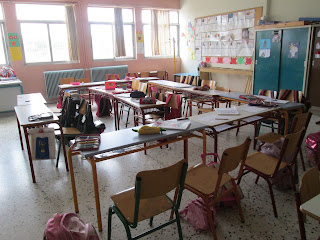Hiihtolomaa edeltävällä viikolla kolmihenkinen seurueemme starttasi kohti Kreikkaa. Matkaan kului kaikkiaan yli vuorokausi; lensimme tiistai-iltana Helsinkiin ja aamulla varhain lähdimme Frankfurtin kautta Ateenaan. Ateenasta matka jatkui junalla kohti Larissaa. Juna mutkitteli neljän tunnin ajan pitkin Kreikan rannikkoa huikeiden maisemien läpi.
Larissassa meitä oli vastassa iloinen joukko kreikkalaisia opettajia ja ohjelmassa oli päivällinen. Pelkästään alkusalaatilla olisi ruokkinut kokonaisen perheen ja reissun aikana saimmekin tottua runsaaseen ruokatarjoiluun.
Vierailun ohjelmassa oli tutustumista Larissan ḱaupunkiin sekä noin tunnin ajomatkan päässä sijaitseviin Kalampakan ja Trikalan kaupunkeihin. Kalampakan lähellä, jyrkkien kallioiden päälllä sijaitseva Meteoran luostari yllätti meidät henkeäsalpaavilla maisemillaan.
 | |
| Alppien yllä |
Larissassa meitä oli vastassa iloinen joukko kreikkalaisia opettajia ja ohjelmassa oli päivällinen. Pelkästään alkusalaatilla olisi ruokkinut kokonaisen perheen ja reissun aikana saimmekin tottua runsaaseen ruokatarjoiluun.
 |
| Alkupalat |
 |
|
43rd
Dimotiko
Scholio Larissas
|
 |
| Koulun rehtorin ja kaupungin edustajien tervehdys |
 |
| Tervetulojuhla koululla |
 |
| Lapset esittivät perinteisiä kreikkalaisia tansseja |
 |
| Oppilaiden töitä |
 |
| Koulun ulkoseinät oli koristeltu maalauksin |
 |
| Kreikkalaisen ja suomalaisen koululuokan välillä on enemmän yhtäläisyyksiä kuin eroja |
 |
| Oppilaiden vanhemmat valmistivat meille lounaan |
 |
| Hyvää huomenta! |
 |
| Yhtenä projektitehtävänä oli vaihtaa kasvien siemeniä. Tässä Bulgarian tuomiset. |
Vierailun ohjelmassa oli tutustumista Larissan ḱaupunkiin sekä noin tunnin ajomatkan päässä sijaitseviin Kalampakan ja Trikalan kaupunkeihin. Kalampakan lähellä, jyrkkien kallioiden päälllä sijaitseva Meteoran luostari yllätti meidät henkeäsalpaavilla maisemillaan.
 |
| Antiikin teatteri Larissassa |
 |
| Opas kertoi, että teatterin päällä oli ollut maantie ja kerrostaloja vielä muutama vuosikymmen sitten |
 |
| Menneisyys ja nykyaika kohtaavat |
 |
| Kalampaka |
 |
| Kalliot olivat kuin toiselta planeetalta |
 |
| Meteoran luostari |
 | |
| Team Finland |
 |
| Perinteisiä kreikkalaisia asuja tanssijoiden yllä |
 |
| Vielä matkan lopuksi team Finland valloitti Akropolis-kukkulan |



























